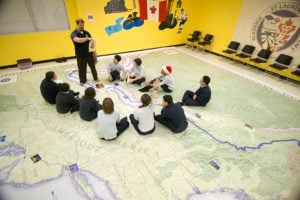Behind the scenes, the project incorporates a plethora of geographic technology to provide an accurate picture of heat escaping a house, including thermal energy information, Geographic Information System data from the City of Calgary and image analysis.
To gather waste heat data for tens of thousands of homes, Hay and his team borrowed the TABI-1800, a state-of-the-art thermal infrared camera produced by ITRES, a local business specializing in airborne remote sensing technology. Over two nights in May 2012, a small plane carrying the camera flew low over Calgary, capturing images of thermal infrared radiation emitted from the surface of geographical features in the city, including rooftops, roads and trees.
Hay and his team then compared these thermal images to GIS data from the city, including property boundaries, house shapes and dwelling ages. Hot spots were determined based on peaks in temperature, allowing the team to assign each dwelling and neighbourhood a Heat Score.
The result is an easy-to-understand heat-loss map of several Calgary neighbourhoods. By locating their homes, residents can compare their Heat Score to their neighbours’, identify waste heat hot spots, and find out how much money and emissions could be saved if the amount of waste heat was reduced.
“We believe that if you see it, you’ll want to do something about it, like I did,” says Hay.
Hay and his team are currently working on incorporating waste heat solutions into the project, such as resources for suggested contractors and manufacturers, so users can easily make the necessary changes to their homes.
For more information and to explore the HEAT project, visit saveheat.co.






